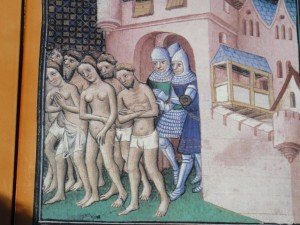The Cathars – Heretics or Martyrs?
Catharism… This new religion scared the Church and was used as a pretext by the King of France to establish his authority. But what was this religion preaching to unite and divide so many people? Together, let’s travel back in time and discover the sad and forgotten story of the brave Cathars.
ENGLISH Transcript
Hi everyone and welcome to my channel French Possum, on which I talk about topics related to the French culture. Today I’ll talk to you about a part of History that is not very well known and yet had a big influence on the south of France and my home region, the Languedoc. We will talk about the Cathars, “heretics” according to the Catholic Church, “martyrs” according to the local inhabitants.
This new religion scared the Church and was used as a pretext by the King of France to establish his authority. But what was this religion preaching to unite and divide so many people? Together, let’s travel back in time and discover the sad and forgotten story of the brave Cathars.
Catharism, a religion
The name “Catharism” comes from the Greek “Catharos” which means “pure”, as the religion used to advocate that mankind’s purpose was to reach perfect soul purity.
Catharism was a religion based on Christianity but it offered a different interpretation of the sacred texts, and in particular rejected all sacraments of the Catholic Church such as the Eucharist.
According to the Cathars, the distinction between Good and Evil was primordial. The Cathars aimed to separate themselves from the material world (which embodied Evil) and ignore human needs. Those who managed to purify their souls were to rest forever into the Good after death. Others had to be reincarnated indefinitely.
The Cathar Priests were called “The Perfects”. They had to obey strict rules that included fasting and refraining from sexual relationships. They were dressed in black and valued work and individual poverty. They also did not eat meat and refused to kill animals, as they believed animals had a soul. They also considered women to be equal to men.
The fight against the Cathars
Catharism spread mainly in the South-West part of France. During the 12th century, it was a very different place from the North of the Loire (French river) region. People were speaking a different language and a brilliant and refined civilization was thriving. The local cites were also freer, more egalitarian and open to foreigners than in the North of France.
The success of Catharism in the region was so quick that it scared the Catholic Church. And yet the Church was partly responsible for this extraordinary expansion: indeed, the Church was at the time heavily criticized and unable to pass reforms. Little by little, the Christian followers were leaving it.
In 1208, following the murder of his legate, the Pope decided to call for a crusade against the Cathars. The King of France, Philippe Auguste, supported the crusade and his vassals gathered 300,000 crusaders that put the Languedoc (the Cathars’ region) to fire and sword. When soldiers asked about how they could find out, among the local people, who was heretic and who was Catholic, it is said that one of the chiefs answered with this terrible sentence: “Kill them all, God will recognize Its own.”
The lords of the South-West region that were supporting the Kind of France realized too late that this crusade had a different goal from murdering the Cathars. Indeed it was all about the King of France trying to establish his authority over the region. The lords then decided to fight against the crusaders but they were defeated in 1214.
Two years later, they rebelled with a large part of the local people and managed to take back several cities. But in 1226, a second yet last crusade was launched against the Cathars and the southern lords. Led by the new King of France, Louis VIII, the crusaders won back all the local cities and peace was signed in 1229.
Following these events, the Inquisition was established with a mission to track and burn all the Cathars. Pushed to the limit, the Cathars rebelled and attacked the Inquisition in 1242. The King of France stepped in again and forced the entire region to relinquish its independence in 1243.
At the end of the war, he laid siege to the Montsegur fortress, where hundreds of Cathars had found refuge. They resisted during a whole year. When the fortress was taken, 200 Cathars refused to abjure their faith and were burned alive. Those who survived the city’s fall ran away abroad. It is said that they took with them a treasure that was never found.
The elimination of the Cathars following the various crusades thus gave the King of France the opportunity to extend his lands and influence on the Cathars’ region, the Languedoc.
Nowadays, the region still retains a unique culture but this culture tends to disappear. The local language, the Occitan, is not taught at school anymore and many inhabitants don’t know their local History. However, the symbol of the region remains the Occitan Cross, which used to be a symbol of Catharism.
Until next week for another topic of French culture. Meanwhile, follow me on social networks. See you soon, bye bye.
FRENCH Transcript
Bonjour à tous et bienvenue sur ma chaîne French Possum, sur laquelle je parle de sujets en lien avec la culture française. Aujourd’hui, je vais vous parler d’un épisode historique peu connu et qui pourtant eu un profond impact sur le sud de la France et sur ma région natale, le Languedoc. Nous allons parler des cathares, « hérétiques » pour l’église catholique, « martyrs » pour les habitants locaux. Cette nouvelle religion effraya l’église et servit de prétexte au roi de France pour assoir son autorité sur la région. Mais que prêchait-elle pour unir et désunir tant de monde ? Ensemble, remontons le temps et découvrons l’histoire triste et oubliée des valeureux cathares.
La religion cathare
La religion cathare tirait son nom du terme grec catharos, qui signifie pur, car elle donnait comme but à l’homme d’atteindre la pureté parfaite de l’âme. C’était une religion basée sur le christianisme mais qui proposait une interprétation différente des évangiles, rejetant notamment tous les sacrements de l’Église catholique telle que l’eucharistie.
Pour les cathares, la distinction entre le bien et le mal était très importante. Ils s’efforçaient de rompre avec la matière, le monde physique, qui représentait le mal, et à ignorer les désirs du corps. Ceux qui parvenaient à purifier leur âme se reposaient à jamais dans le Bien après la mort. Les autres devaient se réincarner indéfiniment.
Les prêtres cathares s’appelaient les Parfaits. Ils devaient observer des règles très strictes, qui incluaient le jeune et l’absence de relations sexuelles. Ils s’habillaient de noir et valorisaient le travail et la pauvreté personnelle. Ils ne mangeaient également pas de viande et refusaient de tuer les animaux, qui avaient une âme. Ils considéraient aussi les femmes comme égales à aux hommes.
La lutte contre les cathares
La religion cathare se développa principalement dans le sud-ouest de la France. Au XIIe siècle, c’était une région bien différente de celle du nord de la Loire. On y parlait une langue distincte et une civilisation brillante et raffinée s’y épanouissait. Les villes de la région étaient également plus libres, égalitaires et ouvertes aux étrangers que le nord de la France.
Le succès de la religion cathare dans cette région fut si rapide qu’il effraya l’Église catholique. Cette dernière fut pourtant en partie responsable de cet extraordinaire essor : elle était en effet à l’époque très critiquée et incapable de se reformer. Petit à petit, les fidèles se détournaient d’elle.
En 1208, suite à l’assassinat de son légat, le pape se décida à lever une croisade contre les cathares. Le roi de France, Philippe Auguste, soutint la croisade et ses vassaux réunirent 300 000 croisés qui mirent à feu et à sang la région des cathares, le Languedoc. Aux soldats qui demandaient comment faire pour distinguer, dans la population, qui était hérétique et qui était fidèle, on dit qu’un des chefs répondit par cette phrase terrible : « Tuez-les tous, Dieu reconnaîtra les siens! ».
Les seigneurs de sud-ouest qui soutenaient le Roi de France comprirent trop tard que cette croisade avait un autre but que d’assassiner les cathares. Il s’agissait en effet pour le roi de France d’assoir son autorité sur la région. Ils décidèrent alors de s’allier contre les croisés mais ils furent vaincus en 1214. Deux ans plus tard, ils se révoltèrent avec une grande partie de la région et parvinrent à reprendre plusieurs villes. Mais en 1226, une seconde croisade, la dernière, fut lancée contre les cathares et les seigneurs du sud de la France. Menée par le nouveau roi de France, Louis VIII, elle soumit toutes les villes de la région qui signèrent la paix en 1229.
A la suite de ces événements, un tribunal d’Inquisition fut créé, avec pour mission de poursuivre et de bruler tous les hérétiques cathares. Poussés à bouts, ces derniers se révoltèrent une dernière fois et attaquèrent le tribunal d’inquisition en 1242. Le roi de France intervint à nouveau et força toute la région à renoncer à son indépendance en 1243. A la fin de la guerre, il mit le siège devant la forteresse de Montségur, où des centaines de cathares s’étaient réfugiés. Ceux-ci résistèrent pendant toute une année. Lorsque la forteresse tomba, 200 cathares refusèrent d’abjurer leur foi et furent brulés vifs. Ceux qui survécurent à la prise de la ville s’enfuirent à l’étranger. On dit qu’ils emportèrent avec eux un trésor qui n’a jamais été retrouvé.
L’élimination des cathares suites aux différentes croisades permit donc au roi de France d’agrandir son territoire et d’étendre son influence sur la région des cathares, appelée le Languedoc. De nos jours, la région conserve une culture propre mais qui a tendance à se perdre. La langue locale, l’Occitan, n’est plus enseignée dans les écoles et l’histoire de la région est méconnue de nombreux habitants. Pourtant, l’emblème de la région reste la croix Occitane, qui fut un des symboles du ralliement cathare.
A la semaine prochaine pour un autre sujet de culture française. En attendant, suivez-moi sur les réseaux sociaux. A très vite, bye bye.









